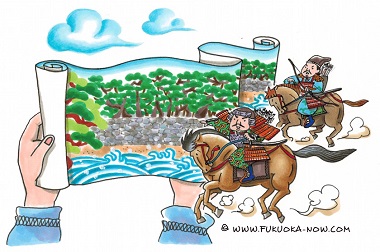Hakata Culture vol.113
The Ikinomatsubara Pine Forest and Genko Borui

A beautiful pine forest extends from Nishi Ward in Fukuoka City all the way to Karatsu City in Saga Prefecture, following the old Karatsu Kaido. Called Ikinomatsubara, this forest located within the Genkai Quasi-National Park has been considered a scenic wonder since olden times, and people have written songs and poems about its beauty for centuries. Today, this area is a popular oceanside driving route because, especially given its proximity to the city, numerous visitors flock here in the summer to enjoy swimming at the beaches.
Ikinomatsubara is also one of the many spots in and around Fukuoka associated with the legendary Empress Jingu. As the story goes, Empress Jingu planted an upside-down pine branch here during the conquest of Silla (an ancient country on the Korean peninsula), and chanted, “If my dream is to come true, grow!” (in Japanese, “negai ga kanau nara iki yo!”). That pine tree she purportedly planted did grow, and that is why the forest came to be called Ikinomatsubara.
One thing that catches your eye in this stretch of forest is the stonework along the coast. This is a restoration of the original Genko Borui, a stone wall erected along Hakata Bay after the attempted Mongol invasion of 1274. In 1281, Mongols invaded Japan yet again, but the Genko Borui was a decisive factor in repelling them during the Battle of Koan. This battle with the 140,000-strong Mongol army in the Ikinomatsubara forest was depicted in a scroll called Mōko Shūrai Ekotoba (Illustrated Account of the Mongol Invasion).
Coastal pine groves can be found along the beaches in many places around Japan, but all of these are man-made: they were planted generations ago to protect rice paddies from wind, sand and waves. Most of the coastal pine groves disappeared as Fukuoka urbanized, but a handful of local groups have been trying to revive them by planting pines along Hakata Bay. In this way, the tradition of hand-planting pine groves continues today as it has for centuries.
Hakata Culture also appears in
(c) www.fukuoka-now.com All Right Reserved
美しい松原に残る元寇防塁
福岡市西区から唐津市へ抜ける旧唐津街道沿いに美しい松林が広がっています。地元では「生(いき)の松原」として親しまれているこの松林は、玄海国定公園内にあり、古くから景勝地として知られてきました。昔から多くの人がその美しさを歌に詠んでいます。現在でも海沿いの景観が楽しめるドライブルートとして人気の場所で、また都心から近い便利な立地のため夏には海水浴場として多くの人が訪れます。
福岡各地には神功皇后にゆかりのある伝説が数多く残されていますが、この生の松原もそのひとつです。神功皇后が新羅遠征の際に、松の小枝を逆さに植えながら「願いが叶うなら生きよ」と唱えたという伝承が残ります。その松が無事に生きたことから「生の松原」という名称がつけられたそうです。和歌などでは「行き」「生き」にかけて歌われています。
松林で目を引くのが海岸線に築かれた石組み。鎌倉時代の文永11(1274)年に蒙古(元寇)の襲来を受け、博多湾一帯に築かれた元寇防塁を復元したものです。この辺り一帯は弘安4(1281)年に再度、蒙古軍が襲来した弘安の役における激戦地。14万の大軍で押し寄せた蒙古軍と生の松原で戦った様子が「蒙古襲来絵図」に描かれています。
日本各地の海岸線に見られる白砂青松の美しい松林ですが、実は自然にできたものではありません。海から吹く風や砂、潮の影響から田畑を守るため、古くから人々が一本一本手で植え、大切に育ててきたものです。海岸沿いの松林は都市化とともに福岡でも姿を消してきましたが、その一方で、博多湾に松林を復元しようと植樹を続けている団体もあります。いつ時代も松林は人の手で守り、育てられてきたのです。

